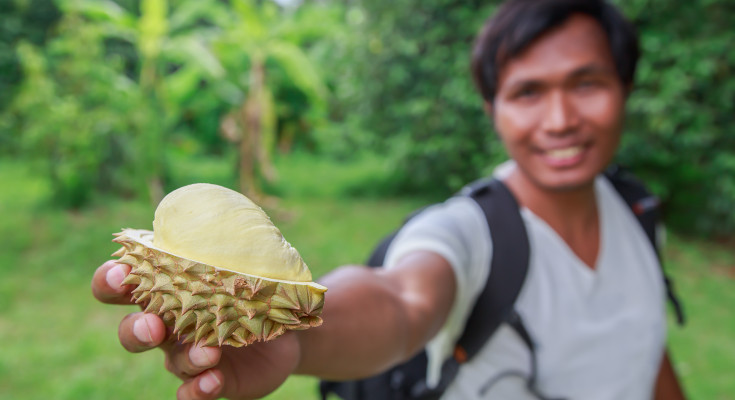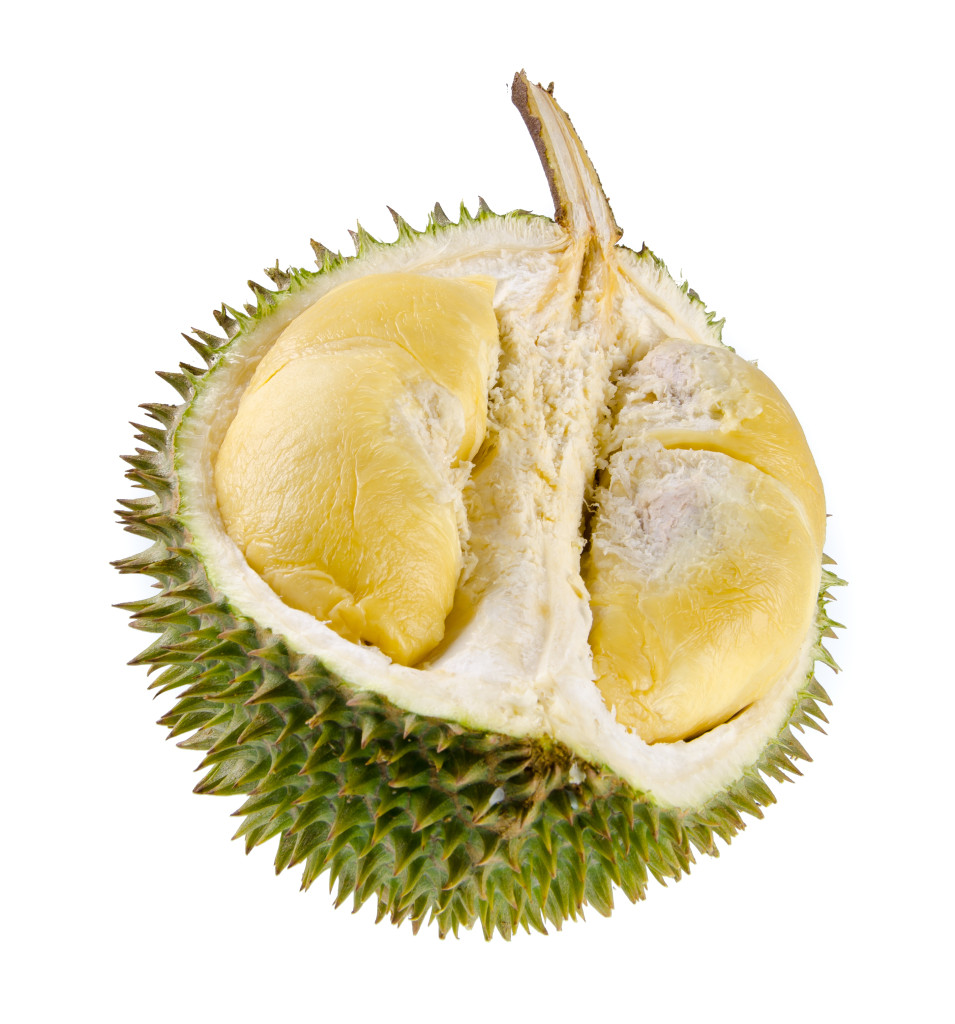|
Love it or hate it, the durian definitely makes an impression. Undoubtedly the most fragrant of fruits, the durian (which gets its name from the Malay word for “thorn”), has spawned legions of critics and devotees (and a surprising number of bad poems). My own memories of durian are, for the most part, unpleasant. My distaste for the stinky, spiny ball of a fruit is largely due to a traumatic experience I had on a rickety, overpacked bus outside of Palembang, Sumatra way back in 1990. I was sitting on top of the engine block next to the driver, overwhelmed by the desire to relieve my cramping legs by stretching them out on some boxes stacked in front of me. Instead, the proud owner of the boxes, a middle-aged Sumatran woman, plopped her feet on top of the durian-packed parcels, sending a powerful blast of durian stench into the air. The combined effects of the smell, my discomfort and my inability to distinguish between the aroma of the woman’s feet and her fruit set my head reeling. Later, after I finally drifted off into an uneasy sleep, the other passengers watched on as I, in a dreamy stupor, tried to close the box and accidentally tickled the woman’s feet. “You want a durian don’t you?” she snapped suspiciously. “No, Bu,” my traveling companion said, mimicking my sleep-drenched words to me later through tears of laughter, “I only wanted some ketchup.” The middle-aged foot-fruit lady thought I was crazy for the rest of the trip. My friend blamed the hot engine I was sitting on. I blame the durian. Of course, I’m not alone. Even its most ardent admirers admit that durian is a weird fruit. “It is like eating a raspberry tart in a lavatory,” Anthony Burgess once wrote, trying to describe the bizarre mixture of sensations one feels on contact with the slimy, stinky, tennis-ball sized pods. One doesn’t eat a durian like one eats an apple or a pear. It is a far more messy endeavor, akin to eating, say, barbecued ribs in its requirement that the diner get down and dirty. First of all, one must break open the spiny outer shell of the durian without damaging the pod-like seeds encased in their respective fluffy white chambers. Once opened, one must negotiate one’s teeth around the seed’s fatty yellow casing, so coveted by durian enthusiasts. More seed than meat, the durian poses difficulties for persnickety gourmets who wish to dine without losing poise. Even once one gets the hang of eating a durian, there remains the obstacle of its overpowering odor. Like Vietnamese fish oil or goat cheese, however, the durian’s rank aroma is, to the devoted consumer, merely a prelude to ecstasy. All hail great Durian — H.S. Whiteside There is, of course, one tell-tale difference between nature’s other debatable delicacies and the durian. Durian somehow manages to maintain—how should I put it?—its aromatic personality after ingestion. For those like myself with traumatic memories of durian, this particular aspect of its consumption comes as a rather shocking surprise. “Ah, durian! It comes out smelling like it did when it came in!” my father-in-law, a serious durian connoisseur, enthused. Cheered at the idea that I was coming to ask him about durian, he saw our discourse as an opportunity to display his knowledge of the coveted—and expensive—fruit. Each durian contains only four pods, barely an appetizer for the true afficionado. With a price of between Rp 80,000 and Rp100,000 per fruit, an average durian feast can exhaust anywhere fup to one million rupiah, making it a status symbol in its own right. For a man like Bapak Nyoman, who cares about getting his money’s worth, choosing the proper durian is as important as eating it. “You have to pick your durian carefully these days,” my father-in-law cautioned. “You see, a ripe durian lets off a strong odor while an unripe one doesn’t smell at all. The wily durian seller will take the fruit from a ripe durian, mix in with water and spray it over the other durians to make them smell ripe and push the price higher,” he explained. But he claimed that a clever consumer can avoid being cheated. “The tell-tale sign of a ripe durian is the slightly hollow sound one hears after thumping its shell. This means that the durian pods inside the fruit have separated and are ready to eat.” He added that discerning middle-class buyers often seek out tree-ripened durians from old orchards, such as the ones of Bestala, North Bali. “You, see, like a fine wine, the older the durian tree the deeper the body and the fuller the flavor of its fruit. The durian trees flower in August and the rush for the Bestala durian begins as early as mid-November even though the harvest season is in January.” “But,” I asked Bapak Nyoman, “how can you stand the smell? I mean, it fills the room, it covers your clothes, it clings to your breath and hands,” I said, nervously trying to push the image of the Sumatran woman’s feet out of my mind. “Oh, John, there are ways around the odor,” he replied consolingly. “All you have to do is drink some water out of the empty shell of the durian. You should wash your hands in the shell, too, so that they don’t smell. There isn’t much we can do about the smell of the durian in our stomachs, though. That part of the durian,” he said, now leaning forward with utter gravity, “has to run its course. You know, John,” he continued, removing his glasses and fixing me with a serious stare, “my daughter told me about your problem with the fruit, the feet and all in Sumatra. It’s an unfortunate story. I myself don’t know what I would do if I couldn’t eat durian.” As Pak Nyoman’s eyes grew misty, I felt we were sharing an intimate moment. Like a Frenchman without wine, an Englishman without beer or an American without low-fat margarine, it is hard to imagine how a real durian lover could enjoy life without an occasional “fix.” Times are now hard, however, for the durian addicts of Indonesia. This is partly due to the recent bans on durian trafficking (even for private use) on most air-conditioned bus lines and airplanes in the country. Indonesia’s durian addicts are often forced to resort to the many durian-flavored foods filling the supermarket aisles to hold them over during bus trips, flights or the long wait for durian season. They can choose from durian ice cream, durian biscuits, durian candy, durian yogurt drinks and durian Dunkin’ Donuts. True devotees—although hopefully not bus drivers—can even buy durian-scented air fresheners. Not everyone can eat durian, however. In Indonesia, popular medical lore categorizes foods according to their relative “heating” or “cooling” qualities. Durian, on a scale of one (cold) to ten (hot), runs about an eleven. People with high blood pressure or ulcers and pregnant women are often advised to avoid durian for health reasons. It is also said that eating too much durian can make one not just giddy but downright drunk. “Your wife’s uncle, Ketut, ate so much durian one day that he just passed out. Durian is like liquor, you have to have something in your stomach before you sit down to a real munching session,” Bapak Nyoman warned. “In the old days, I still remember how my parents used to eat durian with rice and nothing else. We didn’t have much meat [a heating food] in those days and durians grew wild in the forest. To keep ourselves healthy and strong, we ate durian. Some people eat durian with rice to this day. The younger generation gets disgusted at the sight of rice and fruit combinations, though.” Pak Nyoman had already explained to me that durians were quite difficult to cultivate and that the most flavorful fruits were ones that grew wild. I asked him how so many durian trees came to fill the forests of North Bali. “Well, you may have heard about the civet cat known as a lubak,” he said chuckling. “Those little guys could eat an entire durian seed in one gulp and then, after digestion, push out a durian pit complete with fertilizer and all. I should know, I grew up there and saw them do it time and time again. Maybe that’s the root of your squeamishness,” he suggested. “It doesn’t help,” I thought to myself. After all these discussions about durian, I felt daring enough to take my old Balinese language teacher up on his long-standing offer to eat saté and durian at his home in Sanur. Working my way carefully around the pit of the thorny fruit, I actually found myself enjoying its strong, almost alcoholic flavor and dizzying effects. As my teacher broke open yet another, he mentioned an old adage about durian and sexuality. “People always think that men are more sexually aggressive than women. But there’s a saying that goes: the difference between male and female desire is similar to the difference between durians and mangosteens. Men are like durians—you can smell their desire from a mile a way but their fruit is not as strong as their smell. Mangosteens are like women—the fragrance of their desire is hidden to the world but their flavor is twice as sweet as that of a durian.” I could tell, as my face reddened, that I wasn’t the only one who was letting the durian go to his head. First published in Latitudes Magazine |














